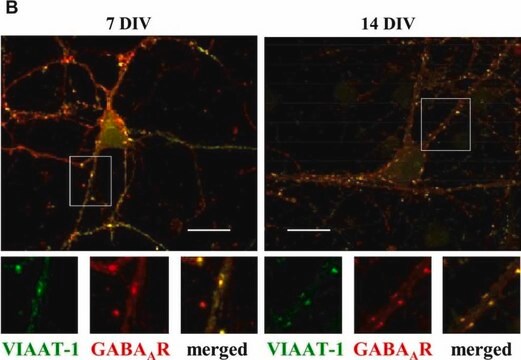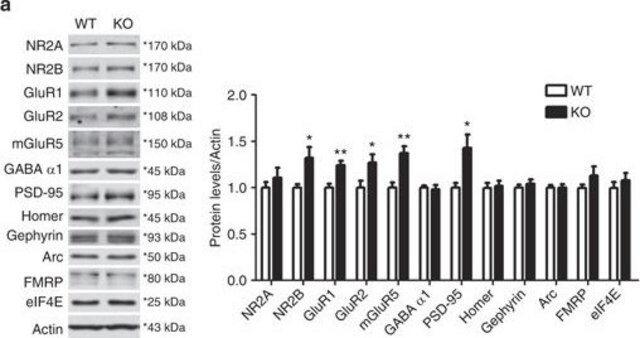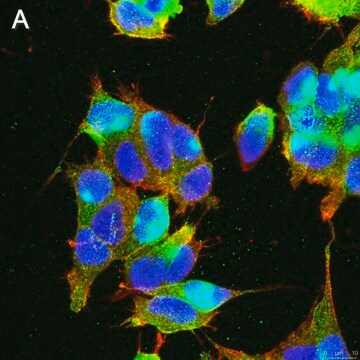05-474
Anti-GABA A Receptor β2/3 Antibody
clone 62-3G1, Upstate®, from mouse
Synonyme(s) :
GABA(A) receptor subunit alpha-1, gamma-aminobutyric acid (GABA) A receptor, alpha 1, gamma-aminobutyric acid A receptor, alpha 1
About This Item
Produits recommandés
Source biologique
mouse
Niveau de qualité
Forme d'anticorps
purified antibody
Type de produit anticorps
primary antibodies
Clone
62-3G1, monoclonal
Espèces réactives
rat, bovine, human
Fabricant/nom de marque
Upstate®
Technique(s)
immunohistochemistry: suitable
immunoprecipitation (IP): suitable
western blot: suitable
Isotype
IgG
Numéro d'accès UniProt
Conditions d'expédition
wet ice
Modification post-traductionnelle de la cible
unmodified
Informations sur le gène
human ... GABRA1(2554)
Description générale
Spécificité
Immunogène
Application
Immunohistochemistry: This antibody has been reported to detect the GABAA Receptor β2 and β3 subunits in paraffin embedded and frozen rat brain sections which had been fixed with 4% paraformaldehyde or 0.1% glutaraldehyde and permeabilized with Triton X-100.
Neuroscience
Neurotransmitters & Receptors
Qualité
Western Blot Analysis: 0.5-2 μg/mL of this antibody detected the GABAA Receptor β2 and β3 subunits from 20 μg of rat brain microsomal preparation (Catalog # 12-144).
Description de la cible
Forme physique
Stockage et stabilité
Remarque sur l'analyse
Brain tissue
Autres remarques
Informations légales
Clause de non-responsabilité
Vous ne trouvez pas le bon produit ?
Essayez notre Outil de sélection de produits.
En option
Code de la classe de stockage
10 - Combustible liquids
Classe de danger pour l'eau (WGK)
WGK 1
Certificats d'analyse (COA)
Recherchez un Certificats d'analyse (COA) en saisissant le numéro de lot du produit. Les numéros de lot figurent sur l'étiquette du produit après les mots "Lot" ou "Batch".
Déjà en possession de ce produit ?
Retrouvez la documentation relative aux produits que vous avez récemment achetés dans la Bibliothèque de documents.
Notre équipe de scientifiques dispose d'une expérience dans tous les secteurs de la recherche, notamment en sciences de la vie, science des matériaux, synthèse chimique, chromatographie, analyse et dans de nombreux autres domaines..
Contacter notre Service technique







